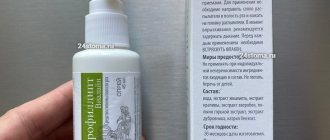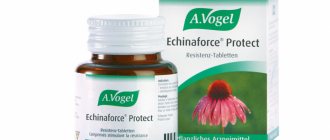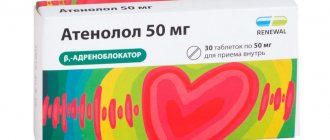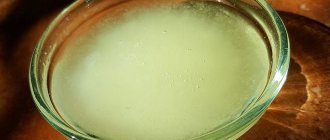Composition and release form
The medicine is dispensed in the following forms:
- The tablets are round, light white or cream in color, with minor inclusions possible. Packaged in cardboard packaging with 1-2 blisters, each containing 10 pieces.
- Syrup - presented as a liquid base with the taste of thyme. Available in 50, 100 and 125 ml volumes. Sold in a glass bottle and secondary cardboard packaging with attached instructions for use.
Active ingredients, regardless of type: ambroxol hydrochloride, sodium glycyrrhizinate. Also dry thermopsis extract and sodium bicarbonate in tablets; liquid thyme extract in syrup.
Auxiliary components: starch, cellulose, talc, nipazole, pure water, sorbitol, stearic acid.
pharmachologic effect
The medicine is intended to treat cough symptoms of any origin. It has a pronounced expectorant and mucolytic effect, and a weak anti-inflammatory effect.
Thanks to the main substances in the composition, the drug promotes the dilution of bronchial secretions and its good discharge.
Due to glycyrrate, there is a decrease in the inflammatory process, the fight against viral agents, and antioxidant properties.
Thermopsis extract stimulates expectoration of sputum, normalizing the secretion in the bronchopulmonary system due to some irritation of the gastric mucosa.
Sodium bicarbonate has an alkaline effect, reduces the viscosity of mucus and stimulates the motility of the epithelial tissue of the bronchopulmonary apparatus.
Thyme plant extract contains a number of essential oils, which contributes to an expectorant, anti-inflammatory and antispasmodic effect.
The pharmacological activity of the drug is aimed at suppressing dry cough, wheezing in the lungs and respiratory failure. In addition, Codelac Broncho reduces the time of intoxication and helps to quickly relieve a runny nose.
Codelac® Neo to relieve dry cough
The Codelac® Neo series includes drugs in the form of tablets, syrup and drops. This variety of choices allows you to completely solve the problem of dry cough in both adults and children, starting from a very early age.
Butamirate, which is the active ingredient of Codelac® Neo, has a favorable safety profile, which has been repeatedly confirmed by research[8]. Butamirate selectively affects the cough center in the central nervous system. Unlike codeine and other opioid antitussives, butamirate is not addictive, it does not depress respiratory function and, as a rule, does not have other negative effects, so it is safe even for children.
Thanks to the pharmacological action of butamirate in Codelac® Neo, the product helps eliminate the cough reflex and reduces the reactivity of the mucous membrane of the respiratory tract. In addition, it has some anti-inflammatory effects[9] and slightly dilates the bronchi. Taking the drug helps reduce the severity of dry cough attacks, reduce their frequency, make breathing easier, and improve blood oxygen saturation. Butamirate begins to act within half an hour after administration[10] and lasts for a long time: syrup and drops of Codelac® Neo last up to six hours, tablets - up to 12 hours[11]. Thanks to this, you can forget about coughing for the whole night.
Note Due to the similarity of the names, many believe that Codelac® preparations contain the narcotic component codeine. This is a misconception. There is no codeine or other substances that could cause dependence and addiction in any medicine in the Codelac® line. As for butamirate, the main component of Codelac® Neo, its favorable safety profile has been clinically proven[12].
Contraindications
The following conditions are absolute contraindications to taking Codelac Broncho:
- Carrying a child and breastfeeding.
- Allergic reaction to the components of the drug.
- Children's age - syrup up to 2 years and tablets up to 12 years.
Use the medicine with caution in case of an attack of bronchial asthma, ulcerative lesions of the gastrointestinal tract and disorders of the liver and kidneys.
Codelac Broncho tablets: instructions for use
Where can I buy
Registration number: LSR-008115/08
Trade name: Codelac® Broncho
Dosage form : Tablets
Description
Flat-cylindrical tablets from light cream to creamy yellowish in color with darker and lighter inclusions, with a score and a chamfer.
Composition per tablet
Active ingredients: ambroxol hydrochloride (ambroxol) - 20.0 mg, trisodium salt of glycyrrhizic acid (sodium glycyrrhizinate) - 30.0 mg, dry thermopsis extract - 10.0 mg, sodium bicarbonate - 200.0 mg.
Excipients: potato starch - 84.30 mg, microcrystalline cellulose - 150.10 mg, povidone (polyvinylpyrrolidone, povidone K25) -26.40 mg, talc - 13.00 mg, stearic acid - 5.20 mg, sodium carboxymethyl starch ( sodium starch glycolate) - 11.00 mg.
Pharmacotherapeutic group
Combination expectorant
ATX Code: [R05CA10]
Pharmacological properties
Pharmacodynamics
A combined drug for the treatment of cough, it has a mucolytic and expectorant effect, and also has anti-inflammatory activity.
The action of Codelac® Broncho is due to the pharmacological properties of its components:
Ambroxol has a secretomotor, secretolytic and expectorant effect, normalizes the disturbed ratio of serous and mucous components of sputum, and increases the secretion of surfactant in the alveoli. Reduces the viscosity of sputum and promotes its removal.
Glycyrrhat (glycyrrhizic acid and its salts) has anti-inflammatory and antiviral effects. It has a cytoprotective effect due to its antioxidant and membrane-stabilizing activity. Potentiates the effect of endogenous glucocorticosteroids, providing anti-inflammatory and antiallergic effects. Due to its pronounced anti-inflammatory activity, it helps reduce the inflammatory process in the respiratory tract.
Thermopsis extract has an expectorant effect, having a moderate irritant effect on the receptors of the gastric mucosa, and reflexively increases the secretion of the bronchial glands.
Sodium bicarbonate shifts the pH of bronchial mucus to the alkaline side, reduces the viscosity of sputum, and stimulates the motor function of the ciliated epithelium and bronchioles.
Pharmacokinetics
Ambroxol.
Suction. Ambroxol is characterized by rapid and almost complete absorption from the gastrointestinal tract. Bioavailability is 70-80%. The maximum concentration in blood plasma after oral administration is achieved within 1-3 hours. Plasma protein binding is 80-90%.
Distribution. The transition of ambroxol from the blood to tissues when taken orally occurs quickly. The highest concentrations of the active component of the drug are observed in the lungs. Penetrates the blood-brain barrier, placental barrier, and is excreted in breast milk.
Metabolism. Approximately 30% of an ingested dose undergoes a first pass effect through the liver. Studies on human liver microsomes have shown that CYP3A4 is the predominant isoenzyme responsible for the metabolism of ambroxol. The remainder of ambroxol is metabolized in the liver to inactive metabolites.
Excretion. The half-life (T ½) of ambroxol is about 10 hours. Excreted by the kidneys: 90% in the form of metabolites, 10% unchanged.
Pharmacokinetics in special groups of patients.
No clinically significant effect of age and gender on the pharmacokinetics of ambroxol was found, so there is no basis for dose adjustment based on these characteristics. The clearance of ambroxol in patients with severe liver failure is reduced by 20-40%.
In severe renal failure, T ½ of ambroxol metabolites increases.
Trisodium salt of glycyrrhizic acid (sodium glycyrrhizinate).
After oral administration, in the intestine, under the influence of the enzyme β-glucuronidase, produced by bacteria of normal microflora, an active metabolite is formed from glycyrrhizic acid - β-glycyrrhetic acid, which is absorbed into the systemic circulation. In the blood, β-glycyrrhetic acid binds to albumin and is almost completely transported to the liver. The excretion of β-glycyrrhetic acid occurs predominantly in bile, with residual amounts in urine.
Thermopsis dry extract.
The components of the extract are well absorbed in the gastrointestinal tract. The maximum effect occurs 30-60 minutes after oral administration and lasts for 2-6 hours. They are excreted from the body by the kidneys, mucous membrane of the respiratory tract and bronchial glands.
Sodium bicarbonate.
Well absorbed from the gastrointestinal tract. The maximum effect occurs 30-60 minutes after oral administration and lasts for 2-6 hours. They are excreted from the body by the kidneys, mucous membrane of the respiratory tract and bronchial glands.
Indications for use
Diseases of the respiratory tract with difficulty in sputum discharge: acute and chronic bronchitis, pneumonia, chronic obstructive pulmonary disease (COPD), bronchiectasis.
Contraindications
Hypersensitivity to the components of the drug, pregnancy, lactation, children under 12 years of age.
With caution: liver and/or kidney failure, gastric and duodenal ulcers, bronchial asthma.
Use during pregnancy and breastfeeding
The use of the drug during pregnancy is contraindicated. If it is necessary to use the drug during lactation, breastfeeding should be discontinued.
Directions for use and doses
Inside, during meals. Adults and children over 12 years old: 1 tablet 3 times a day. It is not recommended to use without medical prescription for more than 4-5 days.
Side effect
Allergic reactions. Rarely - weakness, headache, diarrhea, dry mouth and respiratory tract, exanthema, rhinorrhea, constipation, dysuria. With long-term use in high doses - gastralgia, nausea, vomiting.
Overdose
Symptoms: nausea, vomiting, diarrhea, dyspepsia.
Treatment is symptomatic; gastric lavage is advisable in the first 1-2 hours after taking the drug.
Interaction with other drugs
Combined use with antitussive drugs leads to difficulty in sputum discharge while reducing cough.
The drug increases the penetration of antibiotics into the bronchial secretions.
special instructions
Do not combine with antitussives.
Impact on the ability to drive vehicles and machinery
There are no known cases of the drug affecting the ability to drive a car or use machinery. No relevant studies have been conducted.
Release form
Pills.
10 tablets in a blister pack. 1 or 2 blister packs with instructions for use in a cardboard pack.
Storage conditions
Store at a temperature not exceeding 25 °C. Keep out of the reach of children.
Best before date
2 years. After the expiration date, do not use the drug.
Vacation conditions
Over the counter.
Marketing authorization holder/organization receiving consumer complaints
PJSC OTCPharm, Russia, 123317, Moscow, st. Testovskaya, 10
Tel.:+7, Fax
otcpharm.ru
, 305022, Russia, Kursk, st. 2nd Aggregatnaya, 1a/18, tel./fax, www.pharmstd.ru
Side effects
If the course of therapy is not followed, side effects may occur in the form of:
- Headache and dizziness.
- Weakness and fatigue.
- Rhinorrhea.
- Dryness of the mucous surface of the respiratory tract.
- Dyspeptic manifestations - nausea followed by vomiting, dry mouth, pain in the epigastrium, abnormal stool.
Skin rashes and problems with urination are less common.
Drug interactions
With the simultaneous use of certain drugs, the following effects may develop:
- Chloramphenicol: enhances the effect of codeine;
- Sleeping pills, antipsychotics, antihistamines, sedatives, centrally acting analgesics, anxiolytics: increased depression of the respiratory center and sedative effect (the combination is not recommended);
- Cardiac glycosides (including digoxin): enhancing their action;
- Adsorbents, coatings and astringents: decreased absorption of codeine.






